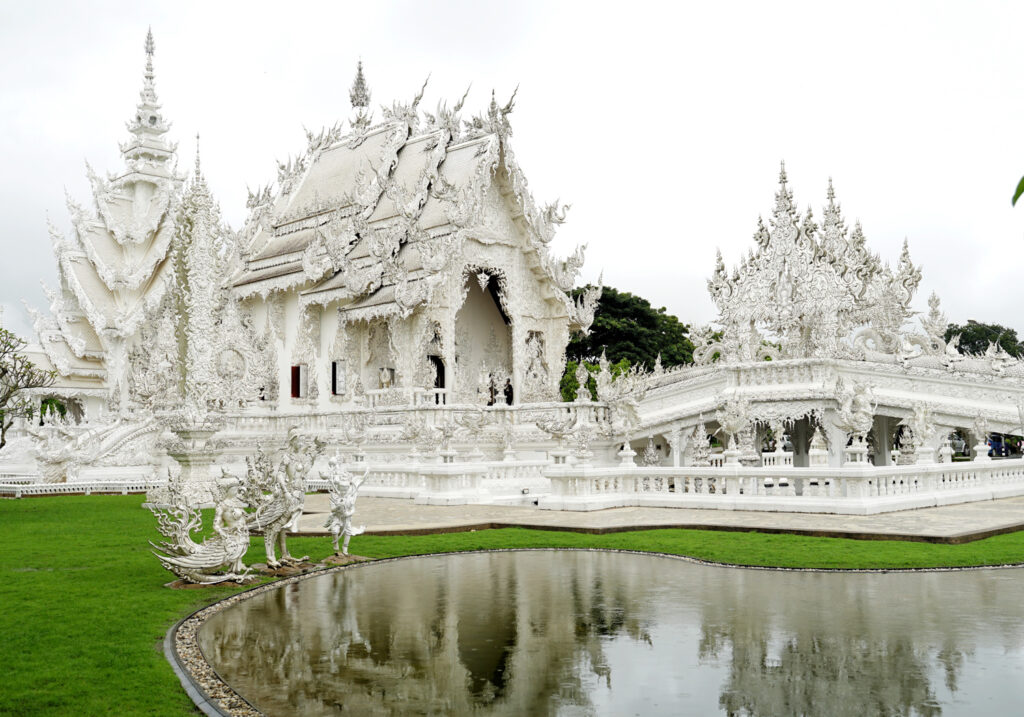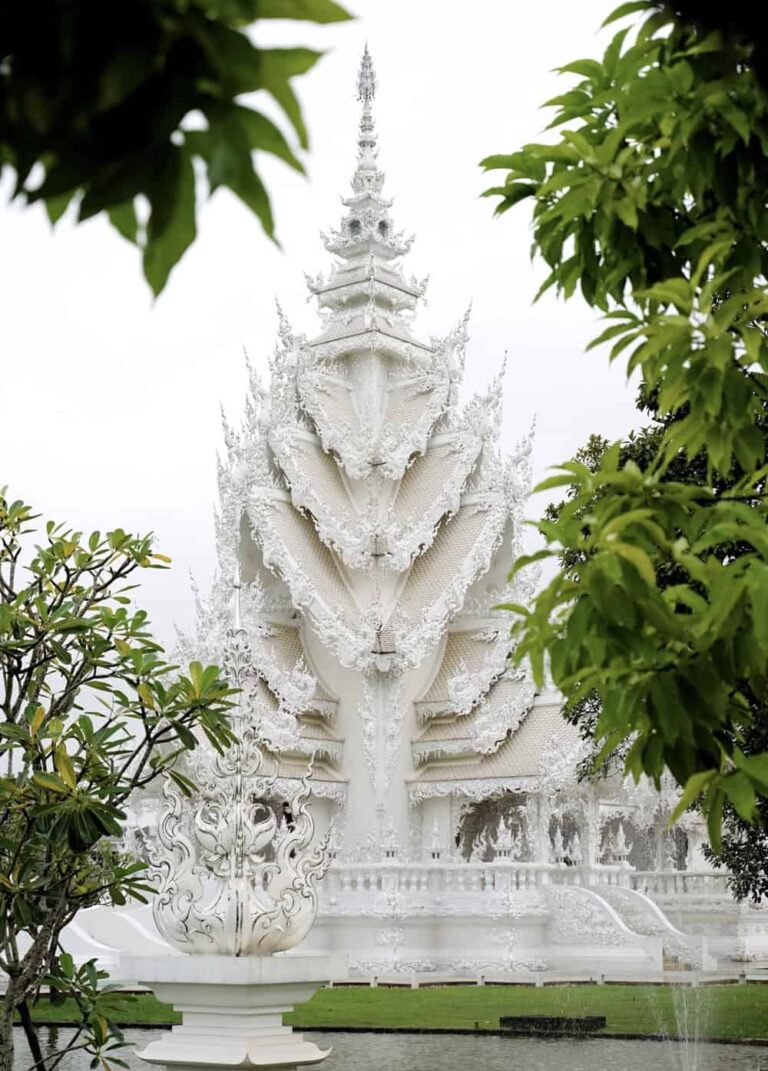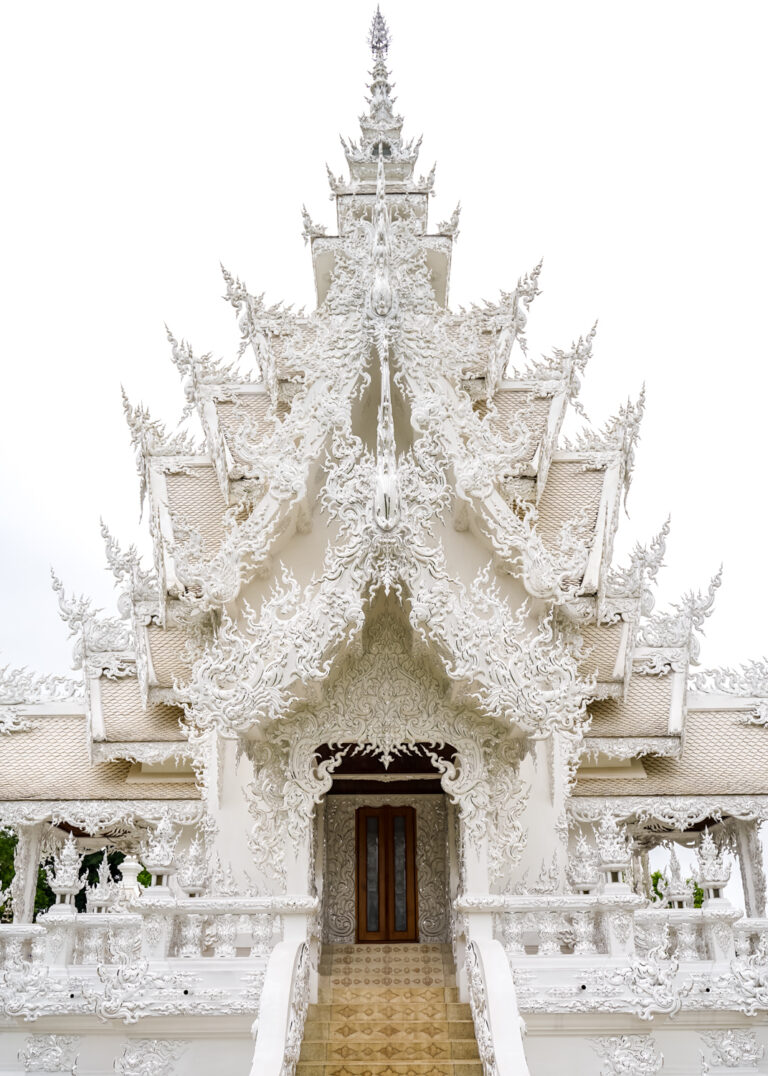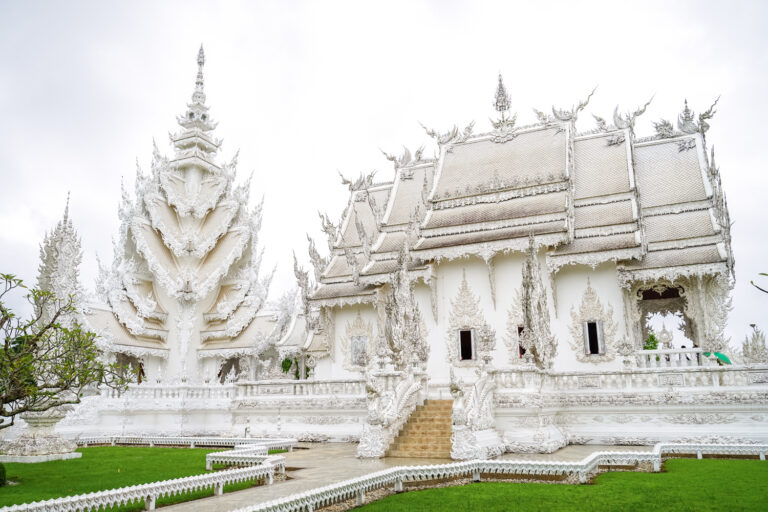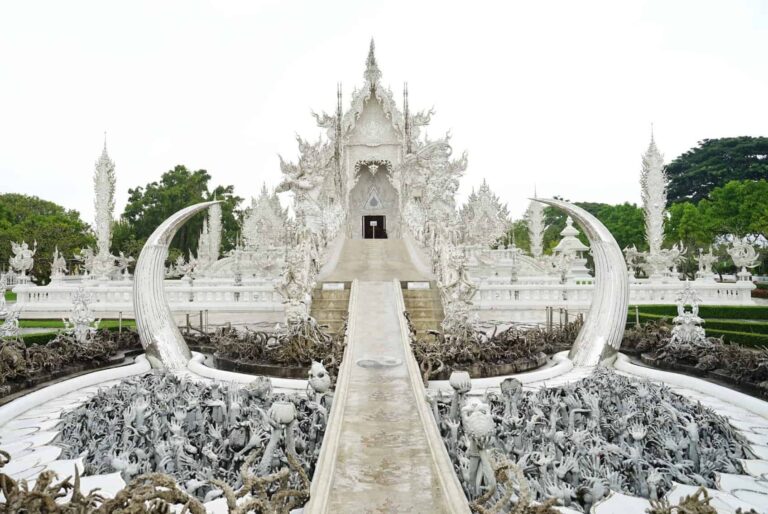Disclosure: This post contains affiliate links that I may earn a small commission from if you purchase something through them. This comes at no extra cost to you!
In the far north of Thailand, close to the borders of Laos and Myanmar, rests the sleepy city of Chiang Rai.
Thailand’s most northern large city is packed full of rich culture and interesting history, with so much to offer any travellers who venture this far north.
Located 190km (3 hours by bus) from it’s younger yet larger sibling city Chiang Mai, Chiang Rai was once a relatively off-the-grid destination for most visitors to Thailand. These days there is a pretty well-trodden route between the two, but Chiang Rai continues to be a much less touristy place in comparison.
With rolling rice terraces, ancient temples, epic waterfalls and an amazing night bazaar, you’re in for a treat if you add Chiang Rai to your itinerary – and you totally should!
Most people visit on a day trip from Chiang Mai just to see the famous White Temple, but I’d recommend spending at least a few days in the city to fully immerse yourself in the culture and see all that the province has to offer.
Table of Contents...
Toggle
Useful information for Chiang Rai
- Country: Thailand
- Language: Thai
- Population: 80,000
- Currency: Thai baht: £1/$1 = 42/37 THB
- Visa info: As of October 1st 2022, many countries can enter Thailand for free with a 45 day visa on arrival. If your country isn’t included you can apply for a 30 or 60 day tourist visa before arriving. After that you can extend for an additional 30 days at immigration in Chiang Mai or Bangkok for around $40. You can onlt do this once before having to physically leave the country.
- SIM cards: There are a few SIM card options that are good in northern Thailand, but the best is DTAC. They have solid reception even in remote areas and offer a great package of unlimited internet at a fast speed of 15mbps for only 200THB (£4.70) per month. It can be topped up at any 7/11 store. Alternatively, buy an eSIM for Thailand here.
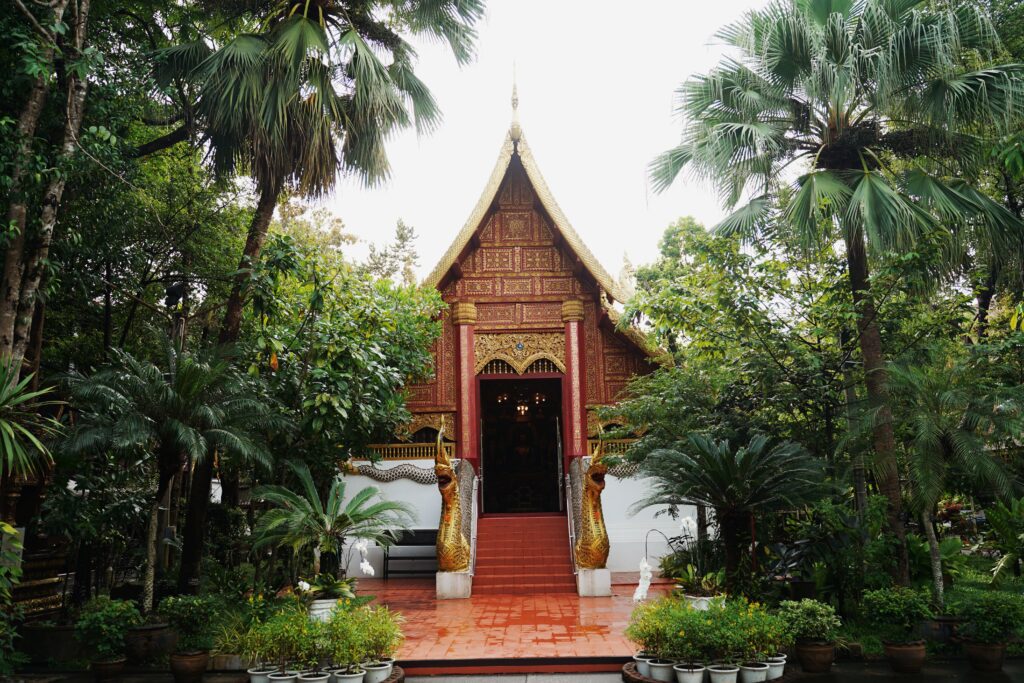
Where is it
Chiang Rai is located in the far north of Thailand, about 800km north of Thailand’s capital of Bangkok, or 200km north of Chiang Mai.
Check it out on the interactive map below.
How to get to Chiang Rai
- Bus: The main way to get to Chiang Rai is to catch a Green Bus from Chiang Mai. The journey lasts around 3 hours and can be booked in advance online for $8/$11. They have 4-5 departures every day but the spaces fill up fast, so best book online with someone like Bookaway.com. From Bangkok a bus is also possible, taking around 13 hours.
- Day tour: If you’re interested in seeing the must-visit attractions in Chiang Rai but don’t have time to stay overnight (although you should definitely make time!) then you can do so on a guided day tour from Chiang Mai. Prices start at around $50. Check tours on GetYourGuide here.
- Flight: Chiang Rai also has a small airport that’s good for domestic flights from Bangkok, although this is obviously the most expensive option and I wouldn’t recommend it.
When to go
This depends on whether you like it wetter and quieter, or hotter but busier.
- Wet season: May – Oct
- Cool season: Nov – Feb (Peak season)
- Hot season: March – May
I visited Chiang Rai in the wet season and sure, it rains, but it isn’t actually that bad. The countryside is lush and the waterfalls are gushing, so I feel like “when’s best” is highly subjective.
How to get around
There are a few different methods of transport in Chiang Rai, but it’s a small city so walking is recommended.
To go further afield, you have 3 options:
- Motorbike: Driving a motorbike is always the way I recommend in southeast Asia, but remember Chiang Rai is a pretty busy city with lots of cars. This will also work out as the cheapest option by far, with scooters costing 150-250 THB per day depending on the engine size. Bikes are available all over the city and your accommodation will usually help sort it out for you. Filling up a bike in Thailand costs 100-200 THB depending on the tank size.
- Grab: A Grab (Asia’s version of Uber) ride across the whole city can cost as little as 60 THB. To use Grab all you need is a local phone number and internet. There are many drivers in Chiang Rai so you’ll never be waiting for too long, and you can choose between motorbike or car rides. With Grab you can pay by card in the App too, so you never have to fiddle around with cash.
- Tuktuk: Tuktuks are normally cheaper than Grab, but make sure to negotiate a price beforehand. They are constantly available around the city and are not very pushy, which is quite refreshing compared to some other cities.
Where to stay in Chiang Rai
Near the Clock Tower is commonly regarded as the best area to stay in Chiang Rai. From there you are walking distance from the downtown attractions like the Night Market. Most hostels and hotels will be found in this area.
I stayed slightly further away at Grandma Kaew Guesthouse, just 800m from the Clock Tower, which was a great location with lovely and helpful staff.
- Use Booking.com or Hostelworld to find somewhere suitable!
Expected costs
Accommodation, food, transport and activities are very affordable in Chiang Rai.
Depending on your travel style, a comfortable daily budget could range from 800 – 1300 THB but it largely depends on your preference of certain things like Thai food vs western food, a private room vs a dorm, Grab vs renting your own bike, and so on.
What & where to eat
Affordable and tasty food is something Chiang Rai does very well, and it’s marginally cheaper than Chiang Mai.
Iconic Thai dishes like Pad Thai or Khao Soi usually cost as little as 40-60 THB whereas western food is more expensive but readily available city-wide too. For example, a pizza can cost around 150-250 THB and a pasta dish around 150-200 THB.
Beer drinkers can pick up a large bottle of Chang or Singha at a restaurant for around 80 THB. Cocktails are usually between 120-160THB depending where you are and soft drinks at a restaurant range from 15-20THB.
How long to stay
Chiang Rai is often thought of as a short stay destination, with lots of people visiting on day trips from Chiang Mai. If you have time, I really recommend staying for 2-3 full days to see the main attractions and local area in depth.
If you’re super pushed for time, you can see the highlights from Chiang Mai, but you’ll spend 6 hours in the car so I guess its up to you.
Thinking of visiting Southeast Asia soon? Don’t miss these essential guides to help planning your trip:
17 awesome things to do in Chiang Rai
1. Wat Rong Khun (White Temple)
The top hit for things to do in Chiang Rai is always going to be the famous and iconic White Temple called Wat Rog Khun.
It’s unique and mesmerising architecture and decorations sometimes sparkle in the sun and the temple draws people all the way from Chiang Mai just to see it. It is truly one of Chiang Rai’s unmissable attractions.
Think of it as more of a work of art rather than a historical temple though, as the White Temple was only built in 1997 after being designed by local artist Chalermchai Kositpipat “in the style of a temple”.
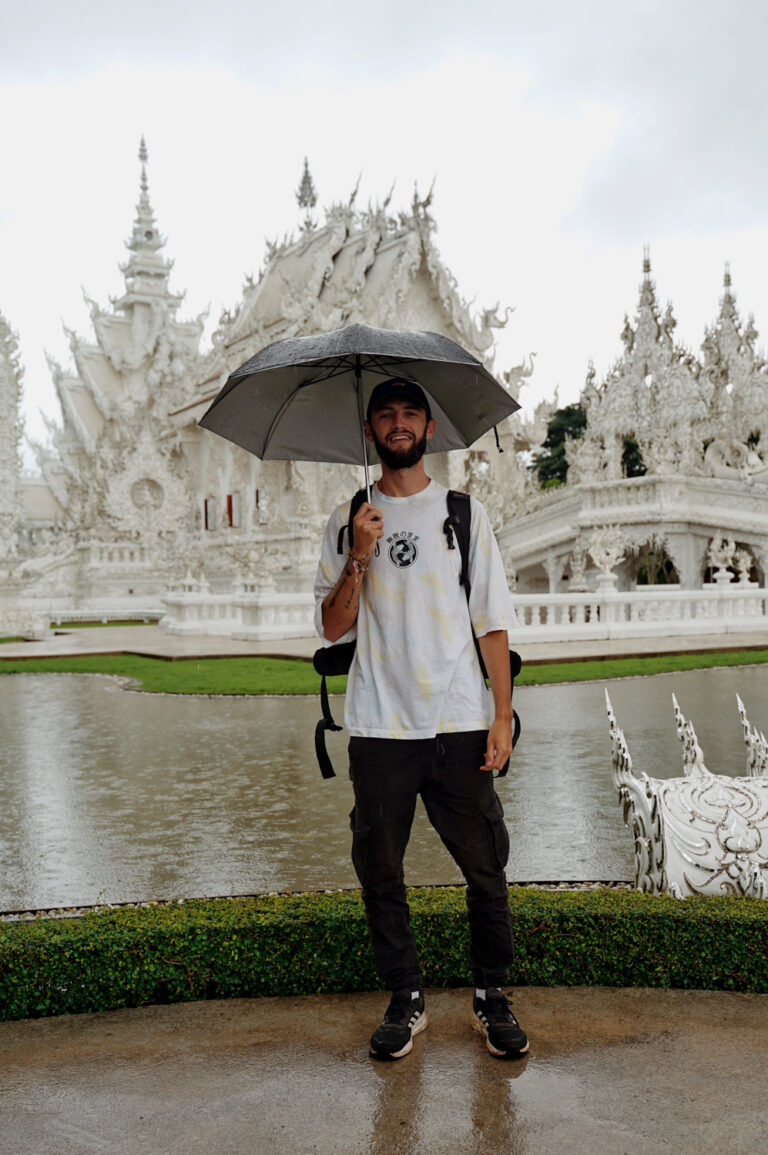
Although jaw-droppingly gorgeous from the outside, the inside of Wat Rong Khun is, well… a bit strange.
No photography is allowed inside otherwise I would have evidence, but soon as you enter turn left and observe the wall. Plastered with images of iconic characters like Captain Jack Sparrow, Minions, Pikachu, Harry Potter, and Neo from the Matrix, I was pretty confused at this point.
Apparently it’s to encourage the younger Buddhist generation to actually come to the temple, but as it’s only really attended by tourists you’ve got to wonder what is really going on there!
This is certainly a unique place, but definitely more of a tourist-focused art piece than a functioning religious site.
Located quite far (14km) from the city centre, you can easily get a motorbike, Grab or tuktuk to the White Temple from anywhere in town. There are also local buses for just 20 THB from the Chiang Rai Bus Terminal.
Entrance is 100 THB but you can get a great view of the temple from the road for free if you’d rather not pay.
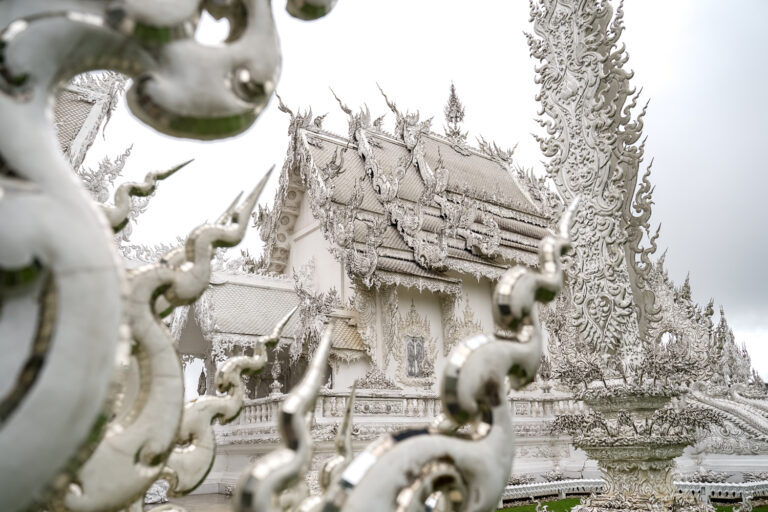
2. Wat Rong Suea Ten (Blue Temple)
The second most famous point of interest in Chiang Rai is Wat Rong Suea Ten (the Blue Temple).
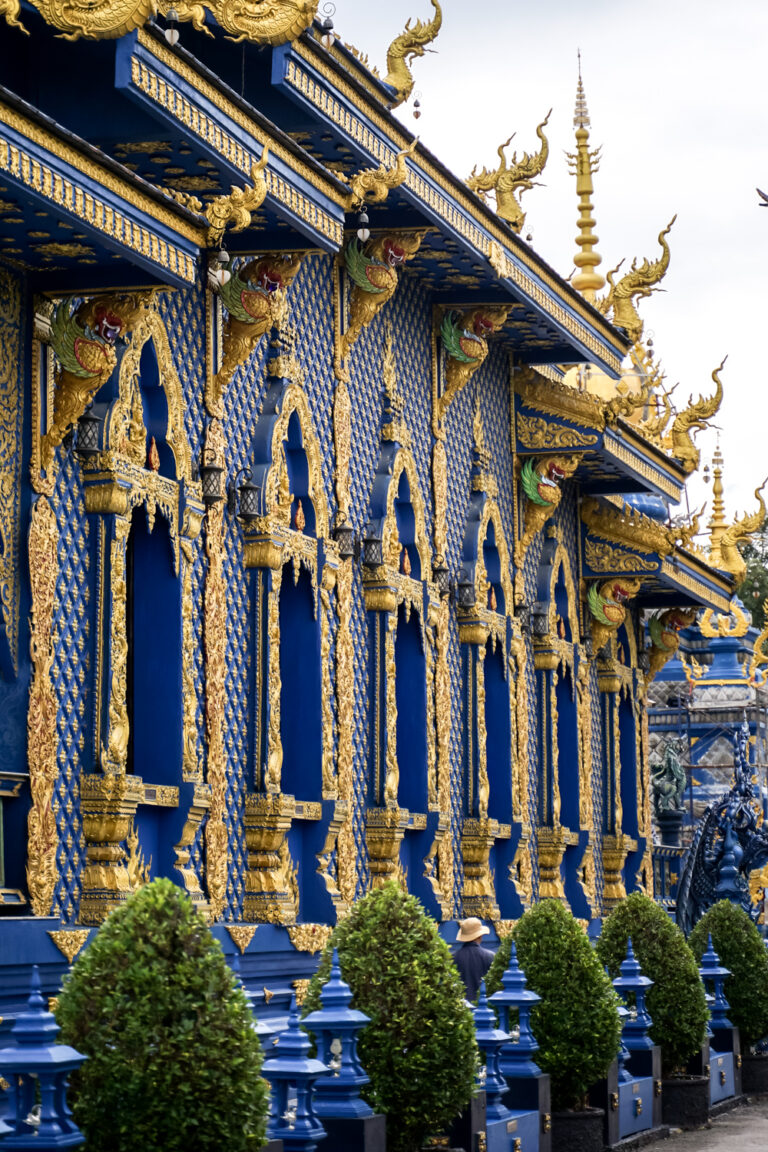
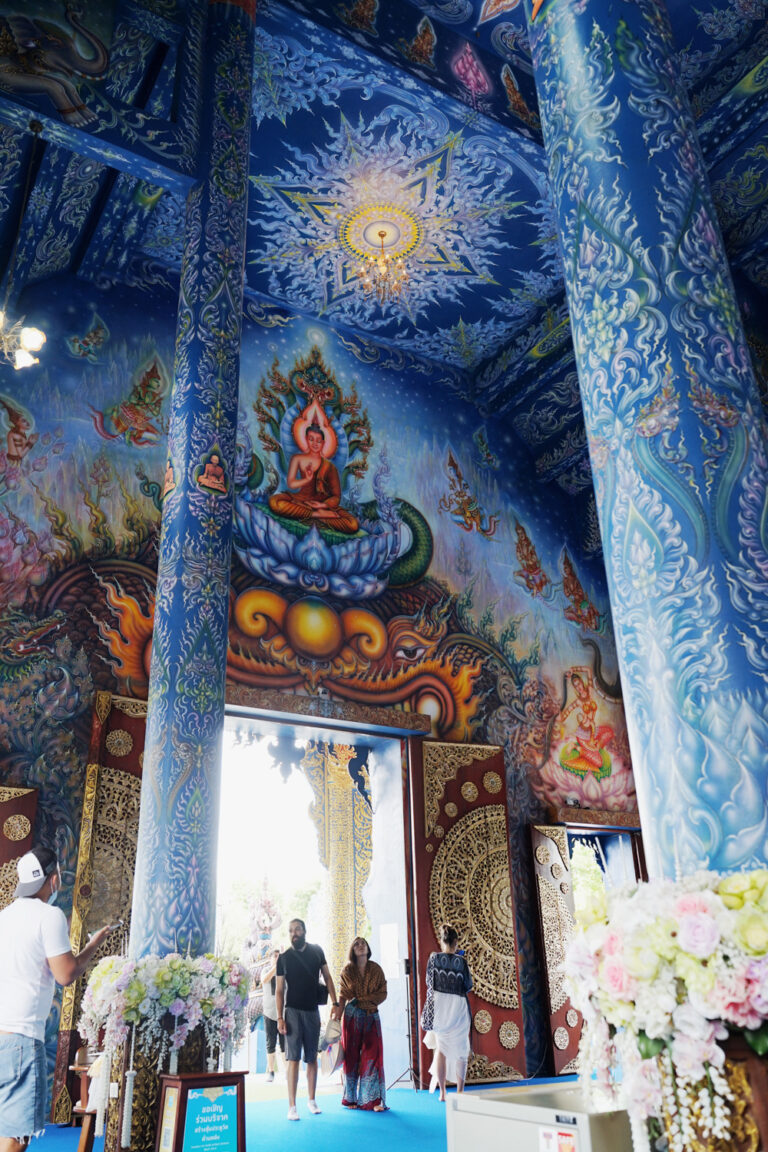
You’ll notice it bears a striking resemblance in design to the White Temple, and the reason for that is it was actually designed by a student of the same artist!
Located about 3km from the Clock Tower and across the river, you should definitely have this on your itinerary for Chiang Rai.
It’s a very young temple, built in just 2005, but even though it’s not that old compared to others around the city, it is still packed with character, not to mention the striking vibrant colours.
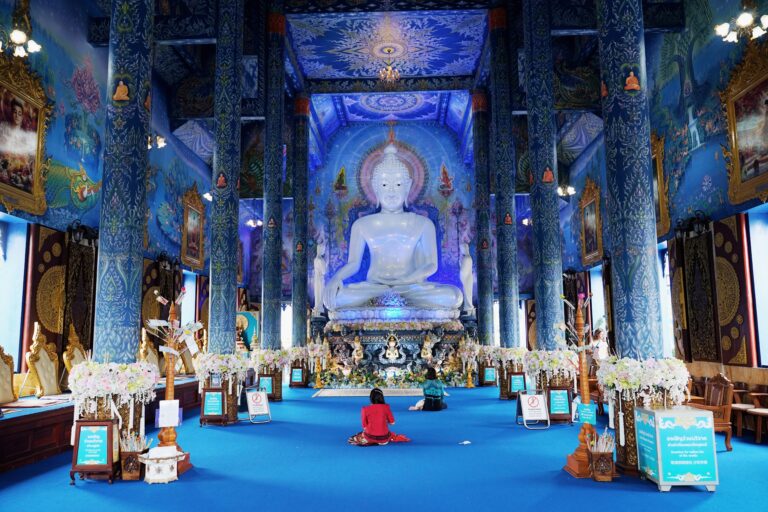
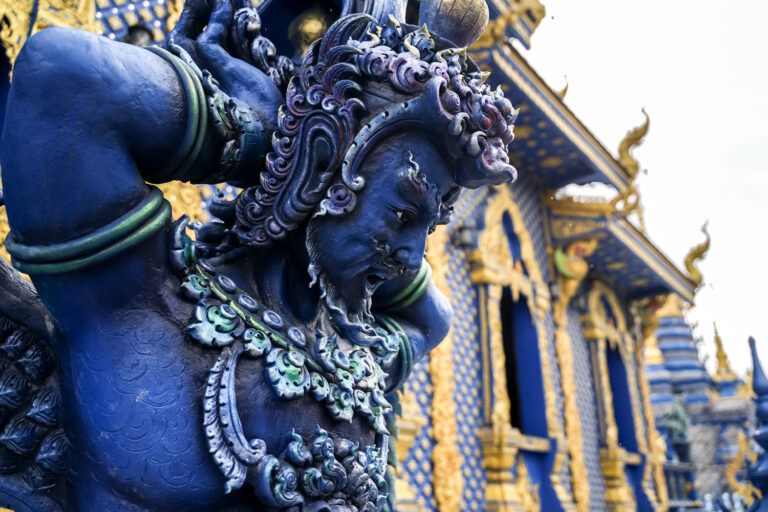
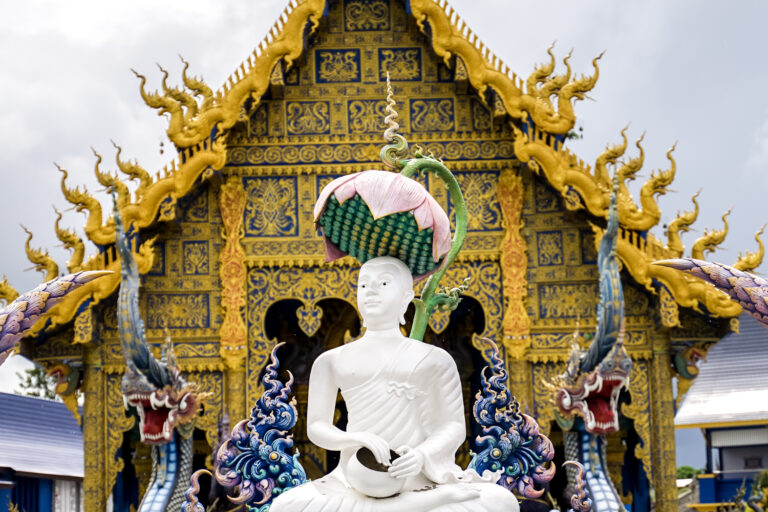
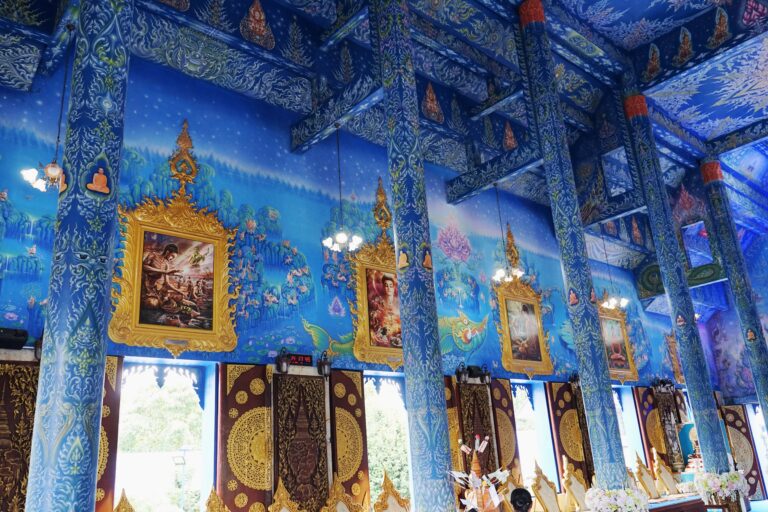
Adorned in many shades of blue, the inside is just as stunning as the outside and it’s also really nice to witness locals actually using this as a religious site, as opposed to the White Temple.
The best part is the Blue Temple is totally free!
3. Baan Dam (Black House)
Three different attractions… three different colour schemes!
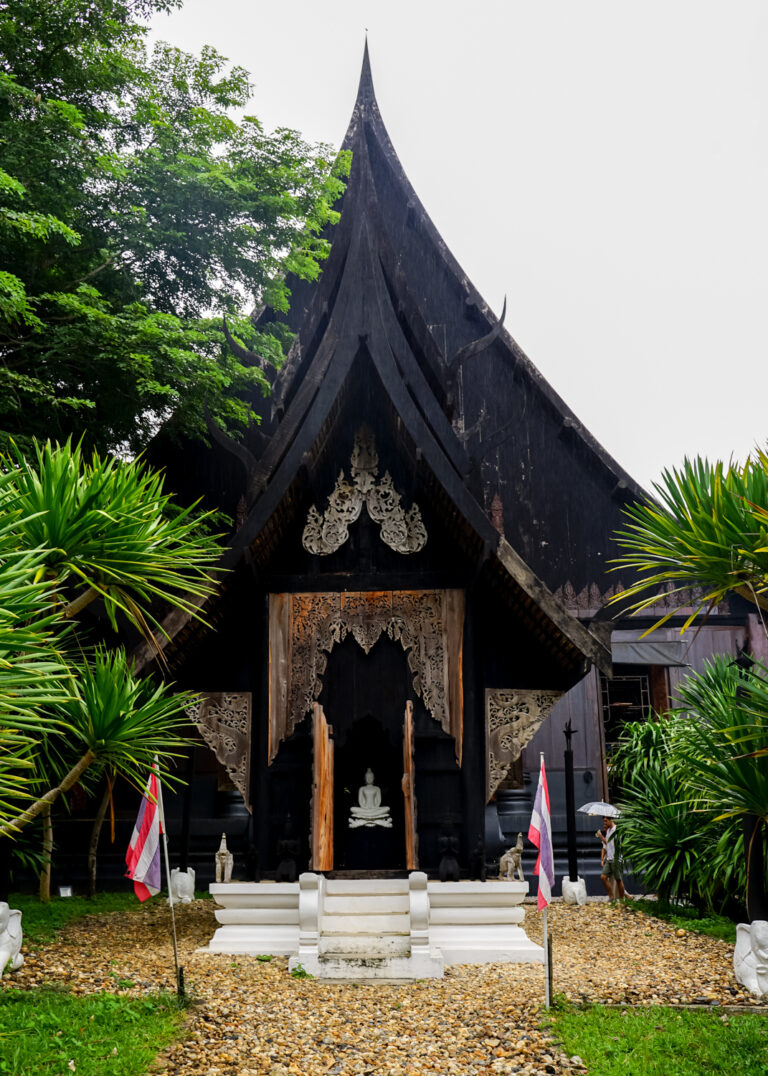
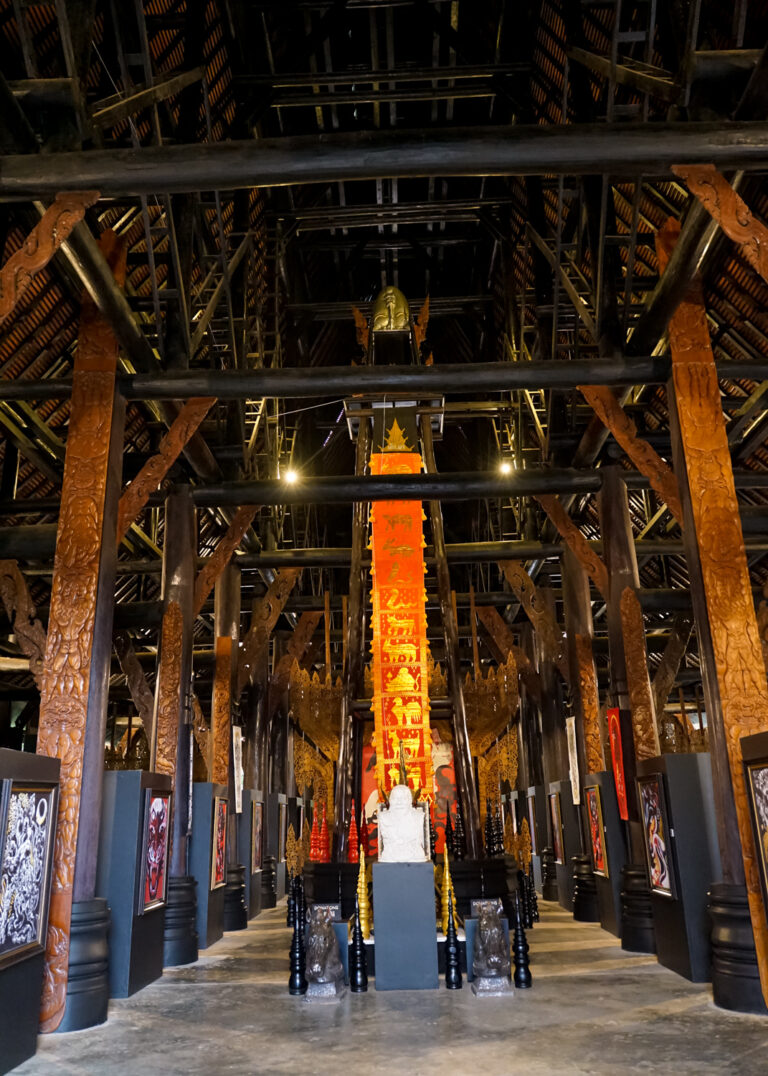
Baan Dam was the home and studio of Thawan Duchanee, a Thai artist famous for his alternative paintings and architecture, and now it’s a museum housing his eccentric work.
His paintings are somewhat unique because, with the aid of a QR code link to Instagram they become animated and dance around your screen. A pretty cool idea, and definitely not something I had seen before!
The whole area is filled with funky buildings and quirky architecture too, so you could easily spend an hour wandering around the exhibits and outhouses.
Baan Dam is 15km north of Chiang Rai so is somewhere many day trips stop at on their way further north, but even if you aren’t planning a day trip it’s worth the drive.
Entrance costs 80 THB.

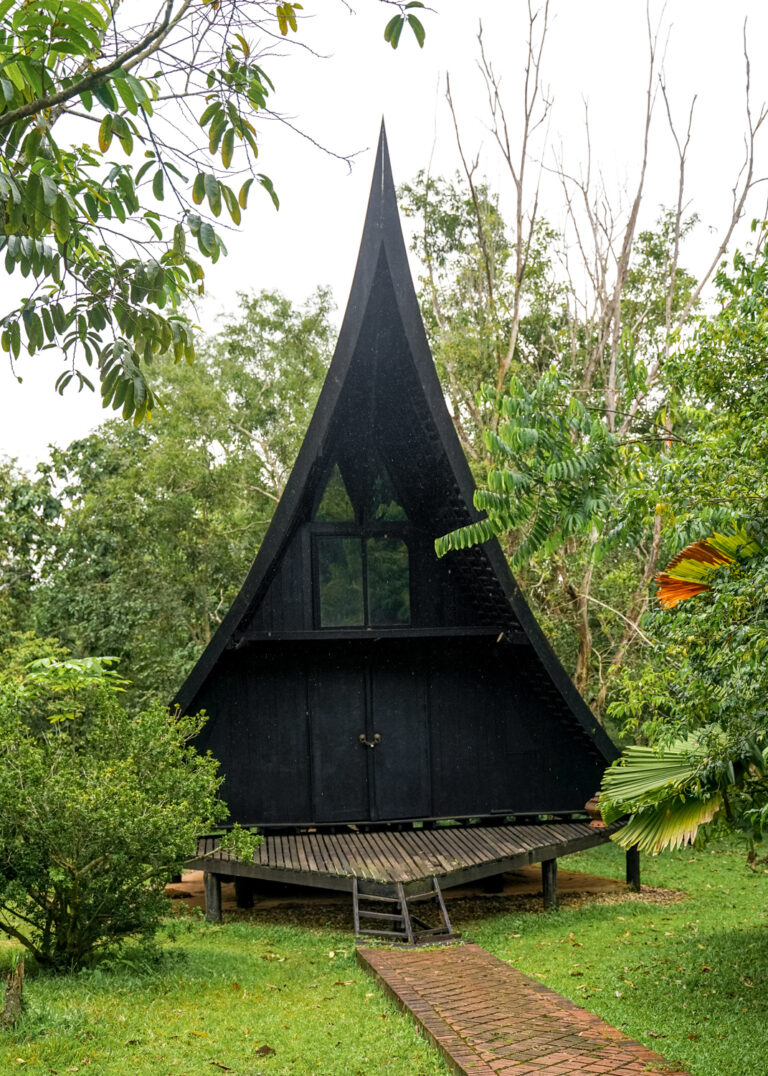
4. Chiang Rai Night Market
The Chiang Rai Night Bazaar is an outdoor market open every evening for some late night shopping and dining. You’ll find it to be a lot smaller than the likes of Chiang Mai’s markets, but with that you’ll get a much more local experience.
Expect to find all your classic market goods like souvenirs, handicrafts and delicious street food.
The Night Bazaar is open from 6pm – 11pm daily just behind the Chiang Rai Bus Terminal.
5. Clock Tower
The Clock Tower was designed by the same artist who designed the quirky White Temple and, although it is used plainly as the centerpiece of a busy roundabout, it is a beautiful work of art.
It’s an iconic landmark of Chiang Rai that marks the centre of town and it’s golden colour stands out in the grey of the city.
Visit at 7pm, 8pm or 9pm any night to see the 5 minute light show.
6. Wat Huai Pla Kang
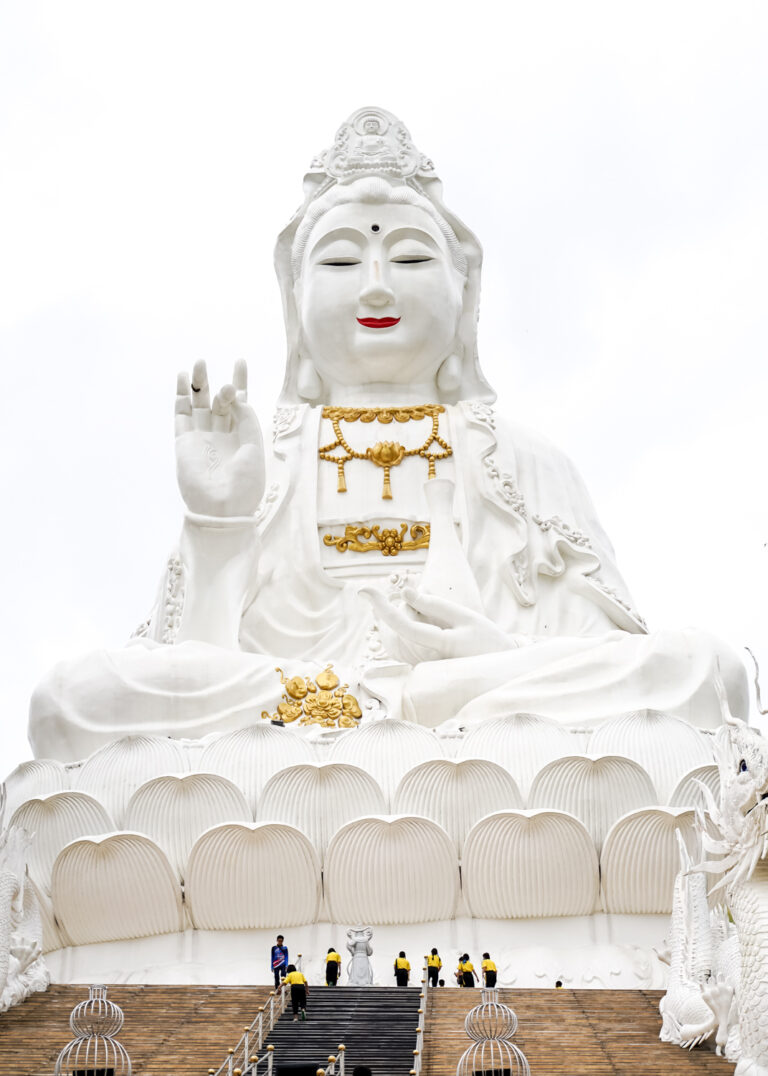
Wat Pla Kang was built in a Chinese-Lanna style architecture which you can see in the photos below, but the real attraction here is this large statue that is often misunderstood as “Chiang Rai’s Big Buddha”.
If you look closely you can clearly tell it isn’t the Buddha at all, unless he recently started wearing lipstick! No, this is actually the Chinese Goddess of Mercy, “Guanyin”.
This is an iconic feature of Chiang Rai that showcases yet even more funky architecture and originality. The large statue dominates the skyline and, being just 7km northwest of the city, Wat Huai Pla Kang is a highlight you shouldn’t miss.
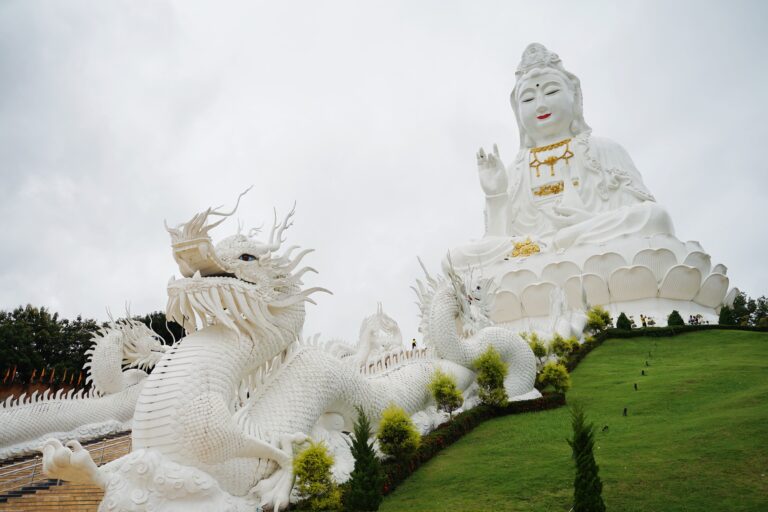
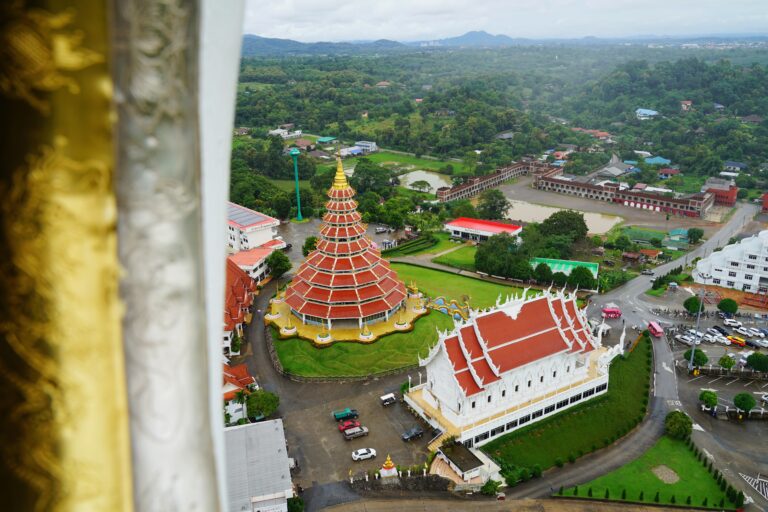
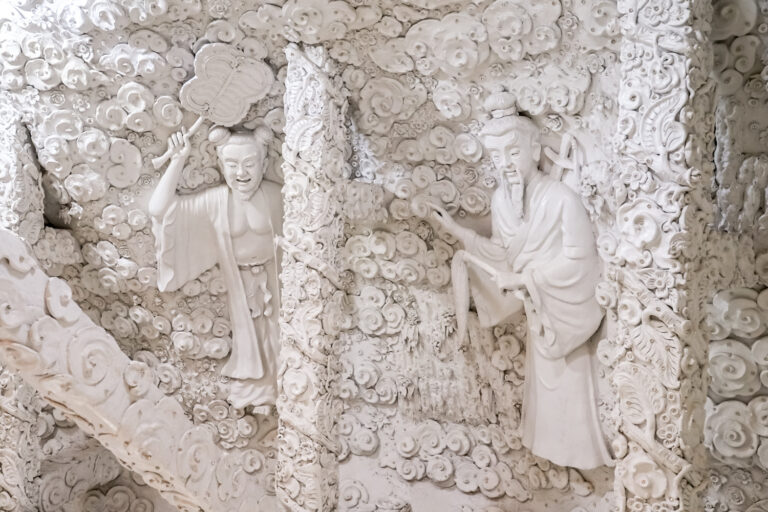
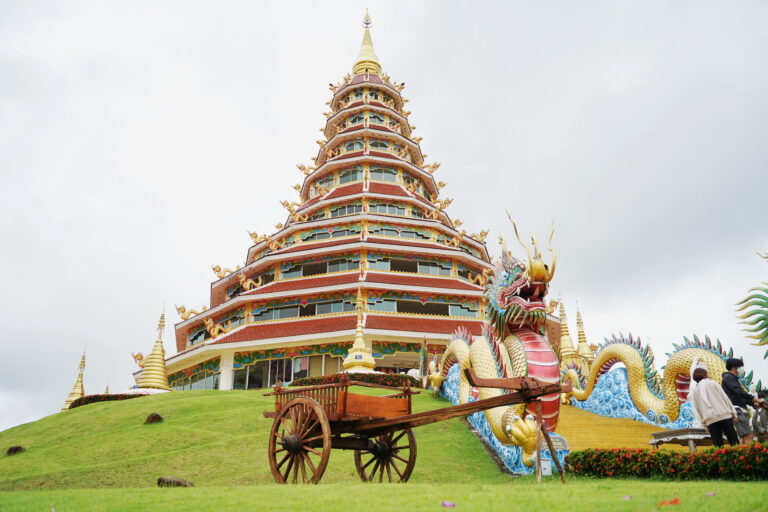
It is a free attraction to visit but for an extra 40 baht you can take an elevator to the top and admire the view from the statue’s Urna (the dot on her forehead) which is actually a window.
7. Take a cooking class
Cooking classes are a very popular thing to do across the whole country.
Here’s an example of some classes on offer through the guesthouse I stayed at.
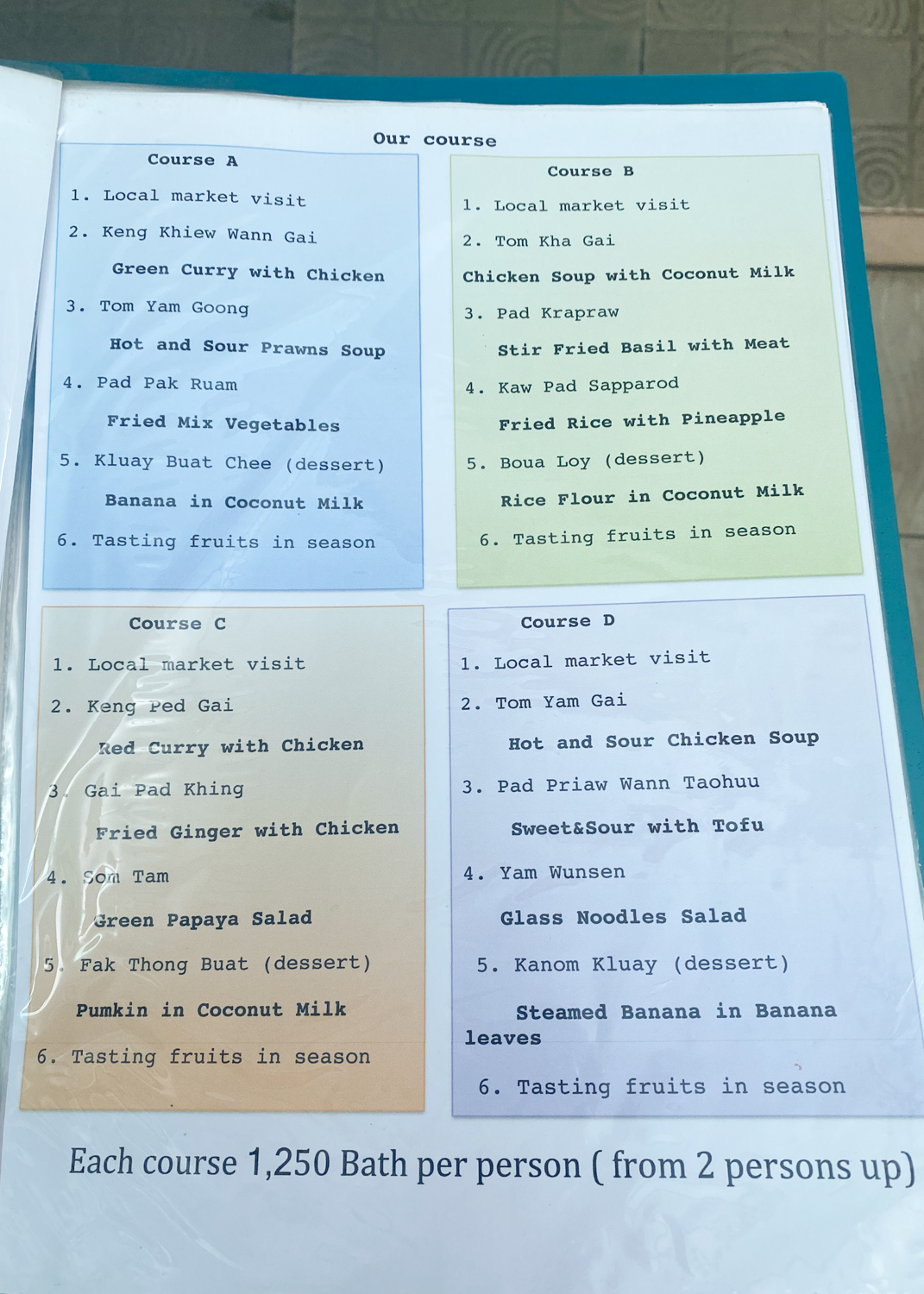
8. Chiang Rai's waterfalls
There are many waterfalls in the Chiang Rai region which I have listed below.
Unfortunately for me, as there had been a lot of rain during my trip, I couldn’t visit any of them as the entire National Park was closed for “safety reasons”. I drove all the way to Pong Phrabat waterfall where I discovered this which was pretty gutting because I love waterfalls (especially in wet season!), but that’s life I guess!
Khun Korn is the most well-known waterfall in the Chiang Rai area and it looks epic. With a height of 70m it is not to be missed… if it’s open!
Waterfalls worth checking out in the Chiang Rai area are:
- Khun Korn – 34km
- Huay Kaew – 24km
- Pong Phrabat – 14km
- Huay Mae Sai – 20km
- Pu Kaeng – 63km
9. Mae Fang Luang Cultural Park
The Mae Fang Gardens host an array of traditional Lanna art within the 3 main buildings.
Check out ancient paintings, teak wood artifacts and the many other exhibitions, or alternatively just wander around the beautiful gardens and soak up the serenity.
The cultural gardens are usually open until 6pm (closed on Mondays) and cost 200 baht to enter, but when I visited they were closed. Luckily I had my drone handy so I could still have a look from above.
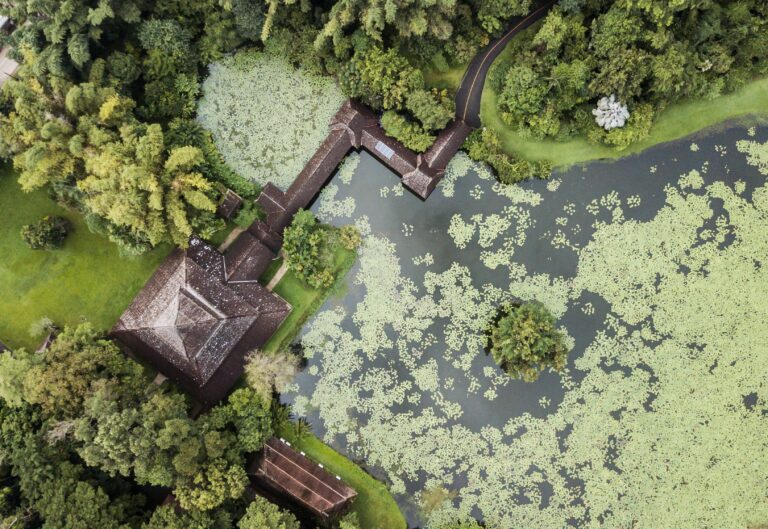
10. The Hill Tribe Museum
The Hill Tribe Museum is a great place to visit in Chiang Rai, especially on a rainy day when you can’t do much else!
Inside there are a few rooms containing very informative exhibitions about the 6 hill tribes in Thailand, including well written English descriptions beside each display which I wasn’t necessarily expecting.
Observe the traditional clothing of each tribe, the tools they use in every day life, the methods they use for farming and survival, and the common issues they face in the present day.
The price is 50 baht and I highly recommend heading here for 30 minutes or so to educate yourself about the different communities who live in northern Thailand and learn something about tribal culture. It certainly made my concerns and beliefs around the Long Neck Tribes more concrete!
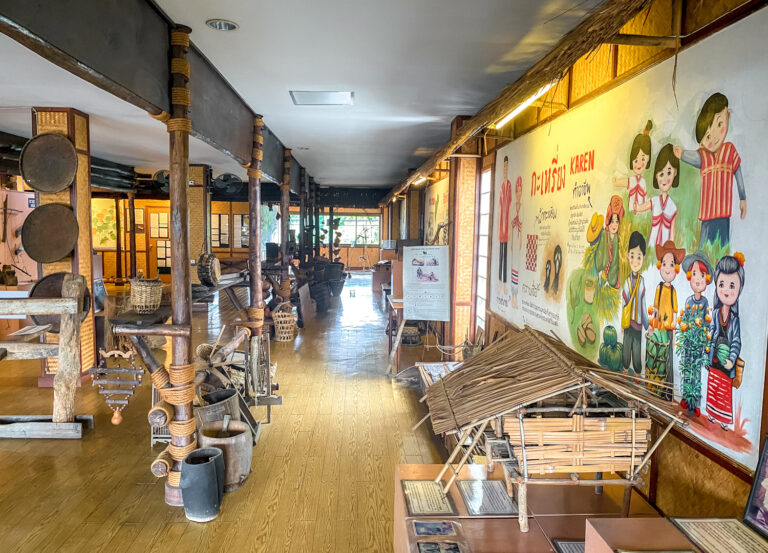
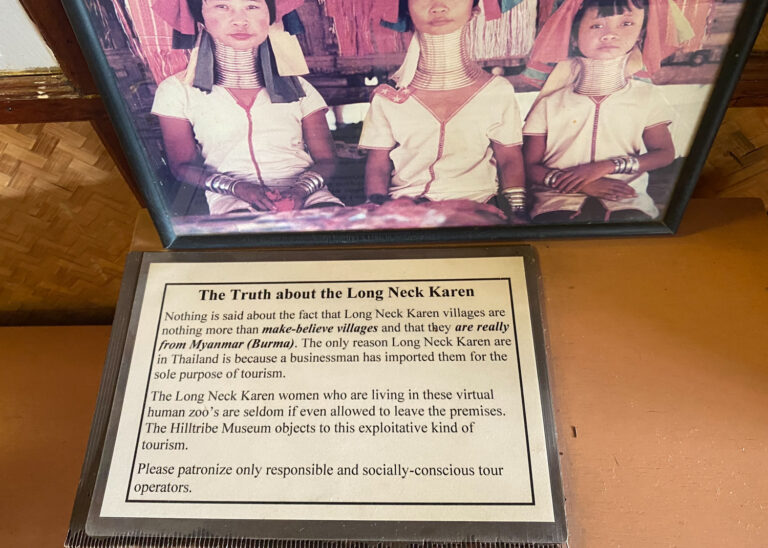
11. Wat Phra Kaew
One of the oldest temples in the city, this is where the famous Emerald Buddha was originally located before being moved to Bangkok’s very own Wat Phra Kaew in 1434.
It’s a free attraction and is surrounded by towering trees with a few other small temples to see while the monks go about their business.
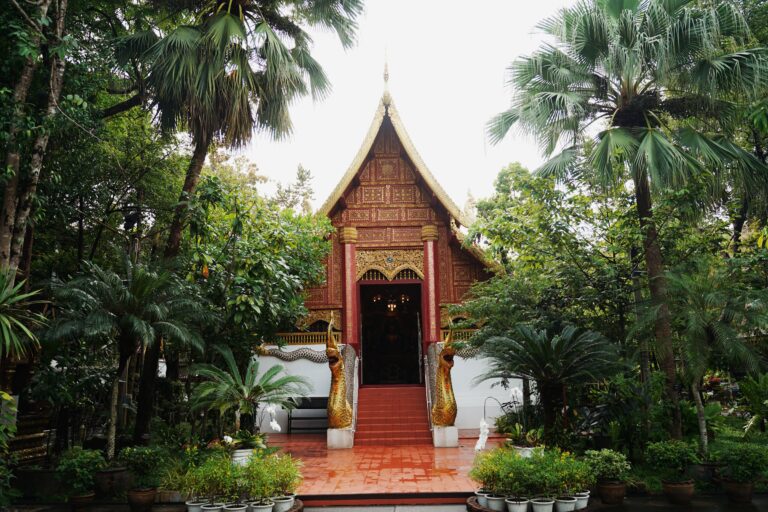
12. Go on a bicycle tour
Take it easy and join a bicycle tour of the beautiful Chiang Rai countryside to see the local rural lifestyle around the outskirts of the city.
Most half day tours will cover 20-25km of leisurely cycling past lush scenery and will include transport to and from the starting/finishing point, a bike, helmet, lunch and refreshments throughout.
The reason I suggest taking a tour is that having a local guide with you means you don’t have to worry about planning a route, getting lost, looking for food or wasting any time looking for cool spots. They will take you on the best route in a stress free environment and feed you lots of information about the area as you slowly pedal past.
To me, the knowledge you get from a local guide is always priceless.
Half day tours start at around 1250 THB.
13. Take a day tour of the northern region
14. Mae Sai (the northernmost point of Thailand)
On the border with Myanmar sits the town of Mae Sai, Thailand’s most northern town.
The two countries are divided by a small river with the Friendship Bridge connecting the two. There are some market stalls by the bridge selling all the typical souvenirs and handicrafts you would expect and lots of food options in this surprisingly lively little town, so if you’re ready for lunch you’re sorted here.
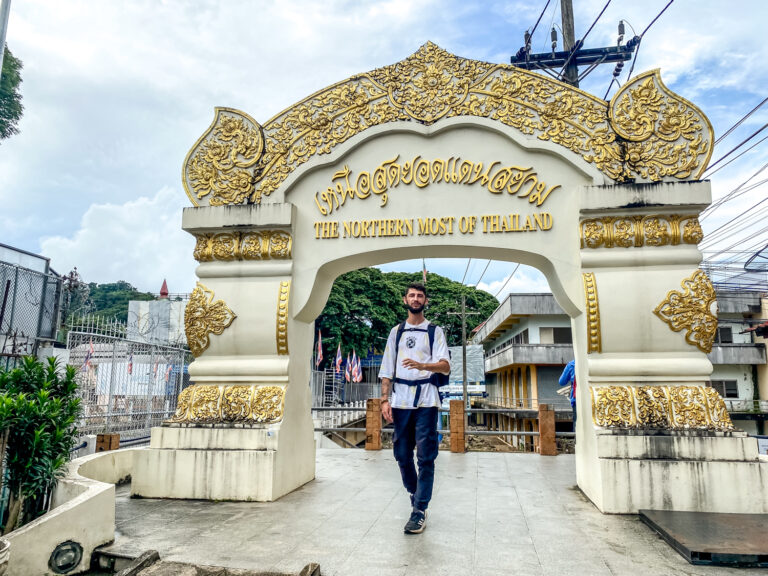
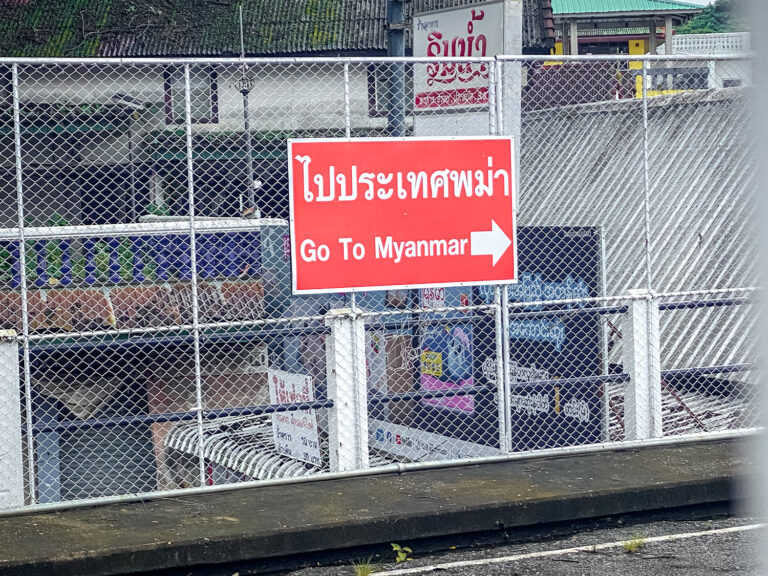
When I visited the bridge and border crossing were closed due to ongoing unrest in Myanmar, but normally Thai people can cross it for just 30 baht. As it was monsoon season, the entire area was damaged from flooding and lots of renovations were going on, but in the dry season the river is sometimes completely dried up so you don’t even need the bridge!
Take a photo at the sign then wave goodbye to Myanmar… but not for long!
15. Visit the Golden Triangle
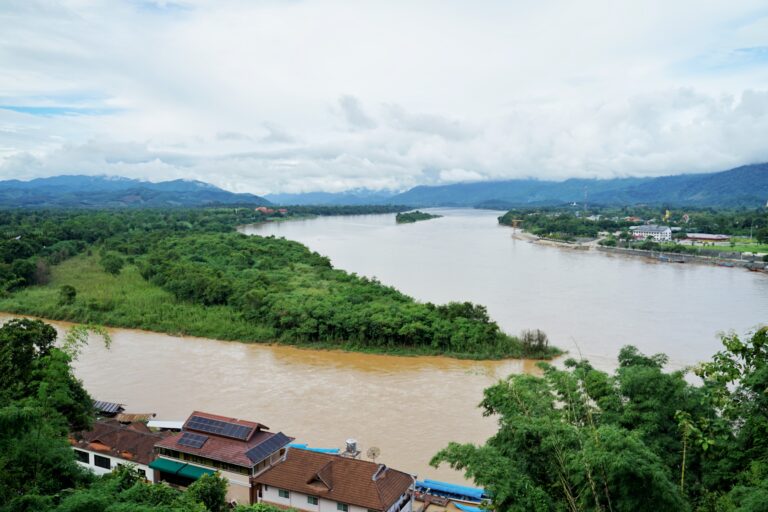
The Golden Triangle is the point where 3 countries (Thailand, Laos and Myanmar) meet along the Mekong River.
As the Mekong River is the actual border dividing the countries you sadly can’t actually stand in three countries at once, but you can admire all three from a viewpoint over the area or from the shoreline where there is a large Buddha statue and some shops.
While you’re there you should definitely check out the Opium Museum which is up next!
16. House of Opium
Opium is a highly addictive drug in the form of a sticky black resin. It comes from young opium poppy seeds and is used legally to make drugs like morphine, cough syrup and sleeping pills, but also illegally, most commonly in heroin production.
Northern Thailand was once one of the leading producers of opium in the world, alongside the likes of Afghanistan and Myanmar, and during the 1960’s the country yielded over 150 tons of the stuff (even though the Thai’s banned it in 1958!). Because it was the only way many farmers could make a living, they continued to grow it.
Nowadays, it is completely banned. The government managed to persuade most farmers to grow coffee instead, but some isolated hill tribes still produce opium for medicinal or personal use.
You will definitely learn something by visiting the House of Opium! It’s right beside the Golden Triangle, but if you don’t have time then check out the Hill Tribe Museum in Chiang Rai which has lots of information on Thailand’s Opium history too.
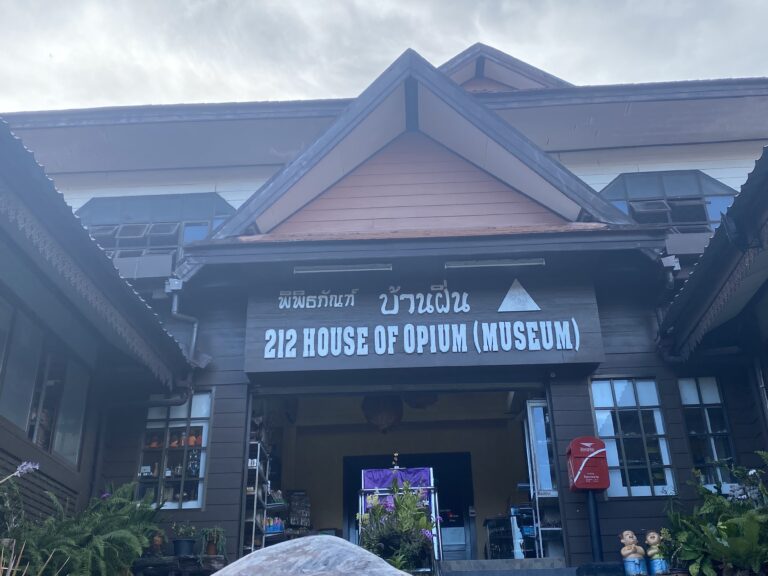
17. Visit a Tea Plantation (Choui Fong)
Choui Fong is the largest tea plantation in northern Thailand and is certainly worth a stop if you’re in the area.
They don’t offer tours of the plantation but it’s a cool place to taste some local teas and try some tea-flavoured treats.
The atmosphere is super relaxed and it’s a great opportunity to take your feet off the gas, kick back and admire the views of the tea fields and mountainous region.
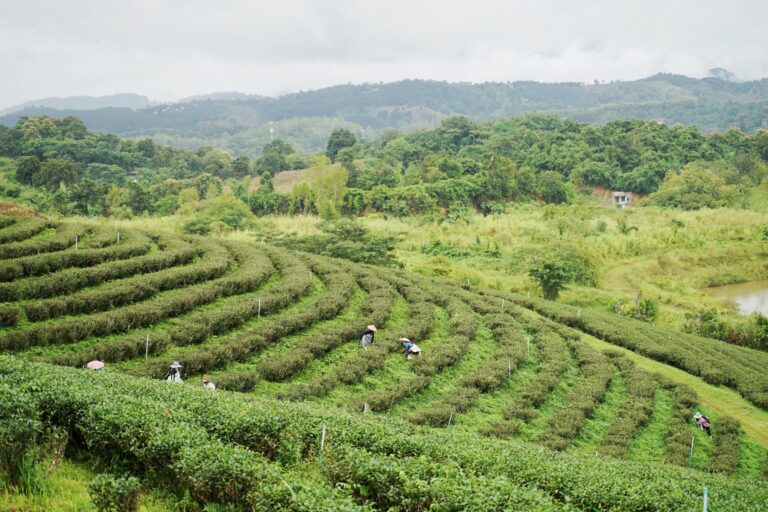
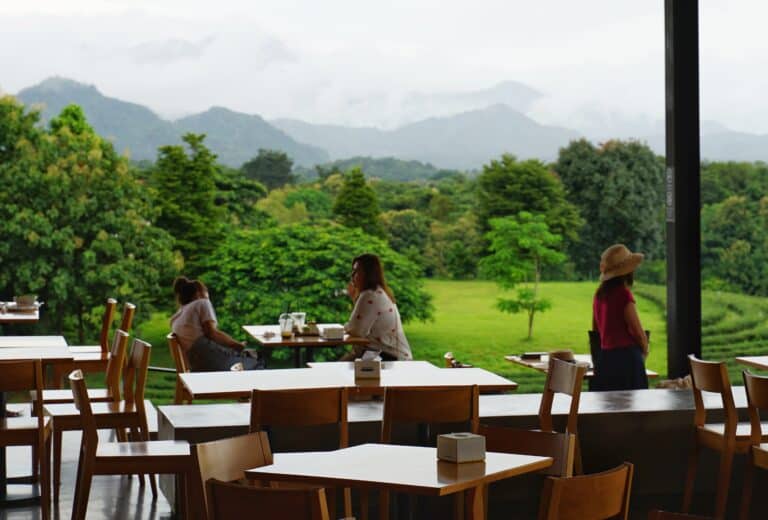
My experience in Chiang Rai
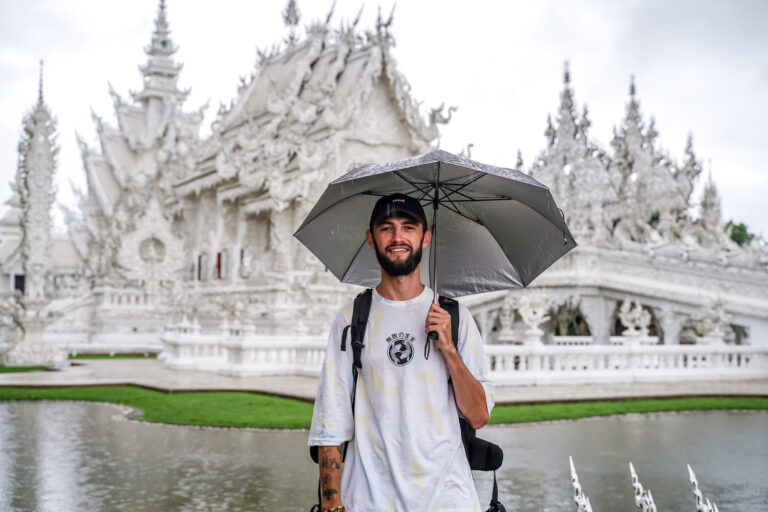
I travelled to Chiang Rai by GreenBus and stayed for 4 nights in September 2022 while on a slow visa-run to the Laos border to renew my Thai visa. Overall, I really enjoyed my time in this city.
I stayed at Grandma Kaew Guesthouse in a double room. From there I rented a bike for the duration of my stay and booked a day tour for one of the days because the weather was terrible the entire time I visited (hence the umbrella) and I didn’t fancy getting soaked on a bike! I also booked a tour because some of the attractions up north are quite far away and sitting on a bike for that long is very uncomfortable for my old-man back!
The extremely small group tour I did via minivan saved time and hassle and squeezed a lot of amazing places into one day. It also meant that if it rained (typically it didn’t on that day!) I would be safe and dry. I highly recommend a tour like this if you’re short on time or aren’t confident to drive a motorbike that far north.
Honestly, compared to the likes of Chiang Mai there’s not that much going on in town itself, but there’s so much to see and do in the local vicinity that it makes up for that. I just struggled to really find the beating heart of Chiang Rai.
It rained non-stop when I was there, but I tried to not let that discourage me from exploring. I was pretty gutted the two waterfalls I tried to see were closed due to the rain because that’s when waterfalls are at their best! That’s the first time I’ve experienced that actually, but I found other things to do instead.
How much did I spend?
Accom: 2160 baht (£53) 4 nights
Day tour: 1000 baht (£24)
Other: 2133 baht (£51)
Total = 5293 baht (£130)
“Other” includes everything like my onward bus ticket to Chiang Khong, all food and shopping, entrance to attractions and bike rental.
Best tours of Chiang Rai

Thank you for reading this travel guide – I hope you found it helpful! Feel free to leave a comment below if you have any questions and I’ll get back to you as soon as possible
Happy travelling!
HELPFUL RESOURCES FOR PLANNING YOUR TRIP
Accommodation: Booking.com, Hostelworld
Tours: GetYourGuide, Viator, Klook, TripAdvisor
Transport: 12Go, Omio, Trip.com, Rome2Rio
WHO IN THE WORLD IS JAMES?
Click below to learn more about my story, including 5 random facts about me, some travel FAQ’s and my entire travel history.
Related posts:
- The Perfect Doi Inthanon Day Trip Itinerary from Chiang Mai
- Taking a 4 Week TEFL Course in Chiang Mai (Honest Review)
- Phi Phi Islands Day Trip from Phuket (Maya Bay Visitor’s Guide)
- Ultimate Pai Travel Guide & 11 Adventurous Things to Do
- Thailand to Laos Visa Run by Bus (Chiang Khong – Huay Xai Guide)
- Complete Chiang Mai Travel Guide & Best Things To Do

